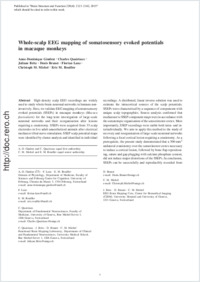Whole-scalp EEG mapping of somatosensory evoked potentials in macaque monkeys
- Gindrat, Anne-Dominique Domain of Physiology, Department of Medicine, Faculty of Sciences and Fribourg Center for Cognition, University of Fribourg, Fribourg, Switzerland
- Quairiaux, Charles Department of Fundamental Neurosciences, Faculty of Medicine, University of Geneva, Switzerland - Functional Brain Mapping Laboratory, Departments of Clinical and Fundamental Neurosciences, University Medical School, Geneva, Switzerland
- Britz, Juliane Functional Brain Mapping Laboratory, Departments of Clinical and Fundamental Neurosciences, University Medical School, Geneva, Switzerland -
- Brunet, Denis Functional Brain Mapping Laboratory, Departments of Clinical and Fundamental Neurosciences, University Medical School, Geneva, Switzerland -
- Lanz, Florian Domain of Physiology, Department of Medicine, Faculty of Sciences and Fribourg Center for Cognition, University of Fribourg, Fribourg, Switzerland
- Michel, Christoph M. Functional Brain Mapping Laboratory, Departments of Clinical and Fundamental Neurosciences, University Medical School, Geneva, Switzerland -
- Rouiller, Eric M. Domain of Physiology, Department of Medicine, Faculty of Sciences and Fribourg Center for Cognition, University of Fribourg, Fribourg, Switzerland
-
04.05.2014
Published in:
- Brain Structure and Function. - 2015, vol. 220, no. 4, p. 2121–2142
Craniotomy
Electrical neuroimaging
High density
EEG
LORETA inverse solution
Non human primate
Sensorimotor cortex
English
High-density scalp EEG recordings are widely used to study whole-brain neuronal networks in humans non-invasively. Here, we validate EEG mapping of somatosensory evoked potentials (SSEPs) in macaque monkeys (Macaca fascicularis) for the long-term investigation of large-scale neuronal networks and their reorganisation after lesions requiring a craniotomy. SSEPs were acquired from 33 scalp electrodes in five adult anaesthetized animals after electrical median or tibial nerve stimulation. SSEP scalp potential maps were identified by cluster analysis and identified in individual recordings. A distributed, linear inverse solution was used to estimate the intracortical sources of the scalp potentials. SSEPs were characterised by a sequence of components with unique scalp topographies. Source analysis confirmed that median nerve SSEP component maps were in accordance with the somatotopic organisation of the sensorimotor cortex. Most importantly, SSEP recordings were stable both intra- and interindividually. We aim to apply this method to the study of recovery and reorganisation of large-scale neuronal networks following a focal cortical lesion requiring a craniotomy. As a prerequisite, the present study demonstrated that a 300-mm2 unilateral craniotomy over the sensorimotor cortex necessary to induce a cortical lesion, followed by bone flap repositioning, suture and gap plugging with calcium phosphate cement, did not induce major distortions of the SSEPs. In conclusion, SSEPs can be successfully and reproducibly recorded from high-density EEG caps in macaque monkeys before and after a craniotomy, opening new possibilities for the long-term follow-up of the cortical reorganisation of large-scale networks in macaque monkeys after a cortical lesion.
- Faculty
- Faculté des sciences et de médecine
- Department
- Département de Médecine
- Language
-
- English
- Classification
- Biological sciences
- License
-
License undefined
- Identifiers
-
- RERO DOC 257269
- DOI 10.1007/s00429-014-0776-y
- Persistent URL
- https://folia.unifr.ch/unifr/documents/304560
Other files
Statistics
Document views: 110
File downloads:
- pdf: 214
- Supplementary material: 128

